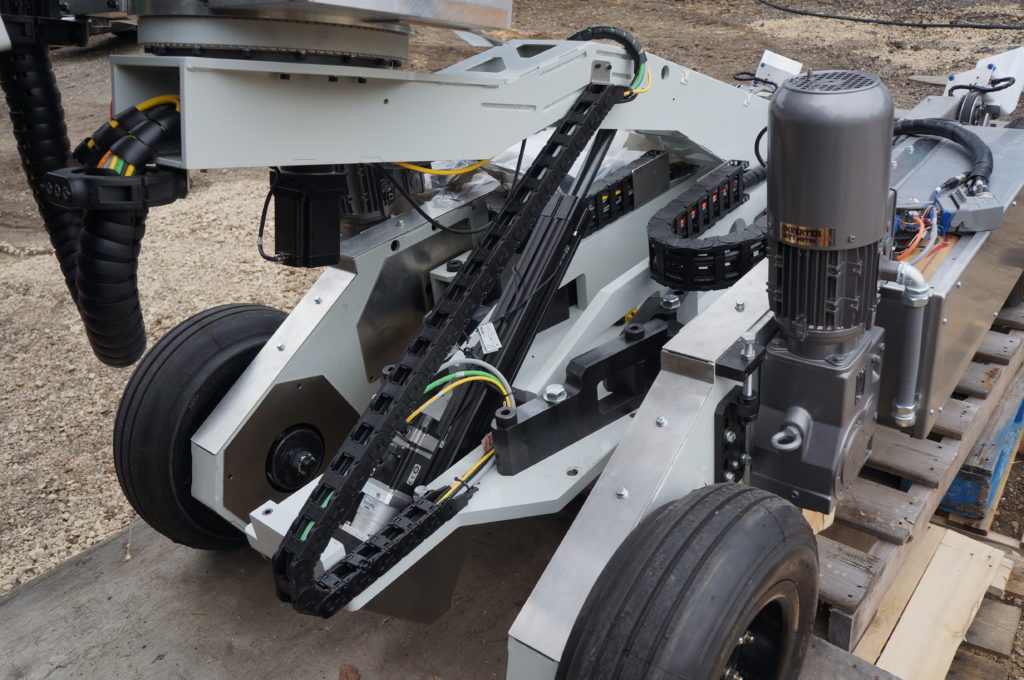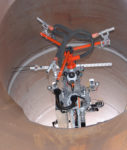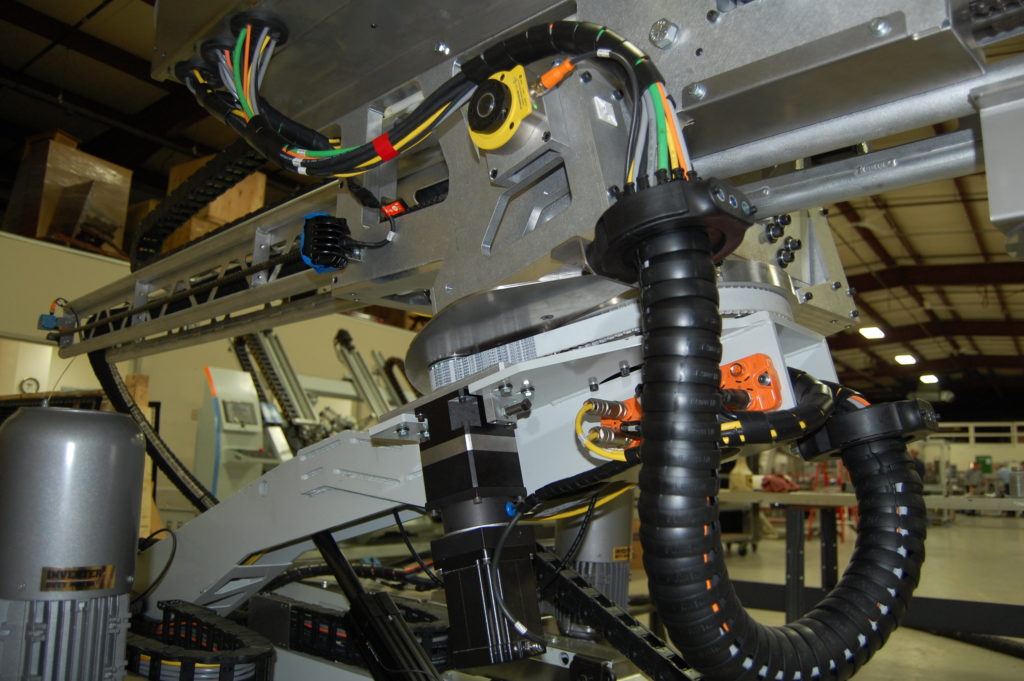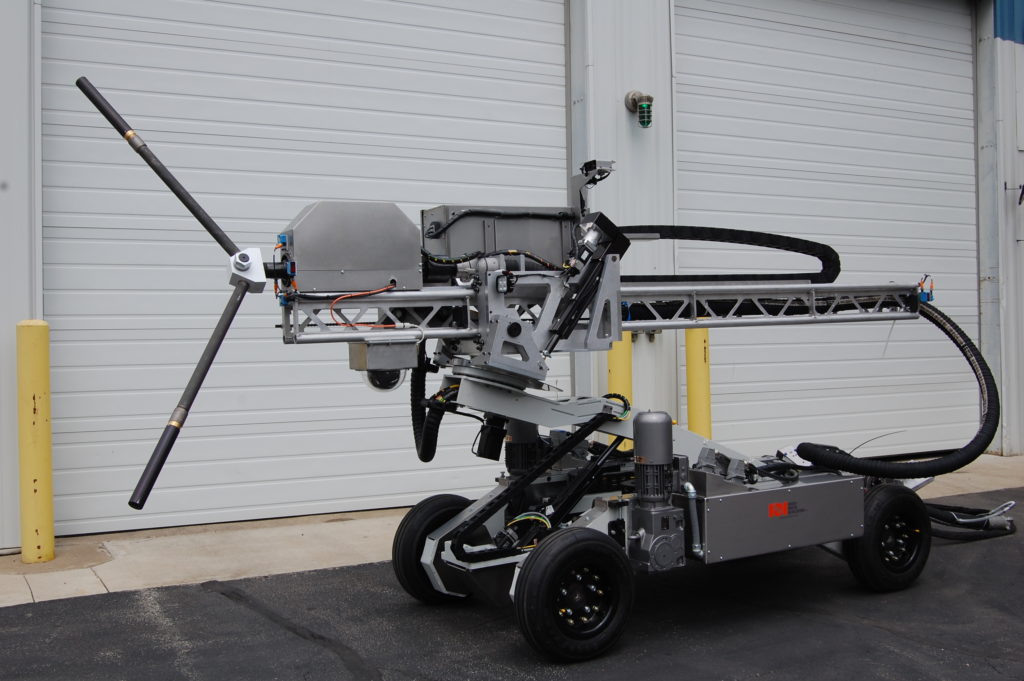Pipeline repair robots deployed to reduce danger for human workers

A Wisconsin company has designed “The Crawler,” a pipeline repair robot that can surface-blast and line midsize to large-diameter pipes. Source: igus
Working underground is extremely perilous. Workers face limited natural ventilation and light; difficult access and egress; and exposure to air contaminants, fire, flooding, and explosion. Pipeline repair robots are emerging to address the challenge.
The risk of underground work to human employees was realized in a deadly Colorado tragedy in 2007. Five workers were killed and three injured in a fire at the Xcel Energy Cabin Creek generating station. Workers were applying an epoxy coat to pipes, called penstock, that require periodic maintenance.
About a dozen workers were inside the penstock when a flash fire engulfed a platform. A flammable solvent being used to clean the epoxy application equipment ignited. The fire grew quickly, preventing the workers from exiting the only egress point within the penstock. The five workers used handheld radios with co-workers and emergency responders for 45 minutes before succumbing to smoke inhalation.
“We were trying every way we could to get in there,” Clear Creek County Under Sheriff Stu Nay told The Denver Post on the day of the explosion.
Developing pipeline repair robots
The dangerous work being performed by workers in the Cabin Creek tragedy is still done mostly through manual labor. A new pipeline repair robot is starting to change that.

The Crawler can travel up to 46 meters per hour during the internal lining process. Source: igus
Remote Orbital Installations LLC (ROI) and Big Sky Engineering in Wisconsin said they have developed a faster and safer alternative to manual labor for pipeline rehabilitation. A robotic platform, which the companies call “The Crawler,” can both surface-blast and line medium- to large-diameter pipe internals.
The automated units have been used to upgrade penstocks installed by BC Hydro in British Columbia. Penstocks, like the ones involved at Cabin Creek, are large-diameter pipes at hydroelectric installations that transfer water from mountain lakes down to generating turbines at a lower elevation. With infrastructure in disrepair the world over, however, The Crawler could be used in many different applications.
“This equipment could basically be used in any pipe or similar structure that needs repair,’’ said Mike Kronz, an engineer who helped design the unit for ROI/Big Sky.
Inside job
The Crawler travels within pipes of varying length to clean the penstock with powerful blasting. The pipeline repair unit then completes the process by re-lining the pipe with epoxy, which prevents corrosion that leads to leaks. Penstock has been rehabilitated in BC Hydro facilities that were constructed in the 1960s and showed signs of deterioration.
In its first project for BC Hydro’s Bridge River facility, The Crawler creeped through 1,731 m (5,679 ft.) of penstock. It moved at different angles all while being controlled by a person from a modified shipping container that is referred to as the “command center.”
“There is all kinds of feedback that can be read in the command center,’’ Kronz said. “There’s an umbilical cord attached to the Crawler that allows for remote operation 2,000 feet from the command center.”
The Crawler’s blasting rate in a 10-foot penstock is about 500 to 600 sq. ft. (152.4 to 182.8 sq. m) per hour, and it travels about 4.61 meters per hour. During the internal lining process, the pipeline repair robot travels at 46 meters per hour (0.041 ft./sec.). For contractors, the lining material cost is about $200 per minute.
Before embarking on its first project in Canada, ROI/Big Sky generated and tested model prototypes to determine how a full-scale automated unit would perform under actual project conditions. To understand this, a full-scale mock-up of a 2.5 m (8.2 ft.) diameter pipe 18 m (59 ft.) long with a 45-degree incline was constructed at the Big Sky facility for testing.
The testing proved successful. After the Hydro Bridge River project, ROI/Big Sky built a second unit to repair 500 m (1,640.4 ft.) of penstock at BC Hydro’s Cheakamus Facility.
The primary advantage of The Crawler is that it minimizes the amount of time workers spend inside the pipe structures, thereby reducing the risk that was inherent in the Cabin Creek tragedy. “This not only reduces the amount of manual labor, but it also is quicker, safer, and performs the work more consistently,” Kronz said.

The Crawler includes several components from igus, including energy chains that protect electrical cables and also allow for the wheel width of the unit to adjust as it moves within the penstock. Source: Igus
Environment requires ruggedized robots
In designing the automated unit, the ROI/Big Sky developers needed to identify components that would endure the stress of a filthy, dusty environment.
“It’s a dirty, rugged environment with a lot of dust and abrasive material,” said Paul Garvoille, who also worked on the pipeline repair machine’s design. “Everything has to be extremely durable.”
The designers found what they needed with components from igus, a German manufacturer of motion plastics. The company runs its North American operations out of Providence, R.I.
The Crawler includes energy chains from igus, which are used to manage and protect electrical cables going from the lower control cabinets to the upper cabinets. They are used in the main boom raise, which allows the boom to extend and contract as it works within the pipe.
An energy chain also allows the wheel width of The Crawler to be adjusted as it moves within the penstock. Diameters vary from 1.5 to 4 meters, and the automated unit is adjusted through the umbilical cord that is controlled by the command center operator.
An igus slewing ring allows the boom to pivot from side to side. There are also servo motor cables that direct boom movement, and in the 500-meter umbilical cord that contains power and control cables along with fiber optic cables.
The durability of the igus products was critical to the success of The Crawler.
“We’ve done several projects and we haven’t had a single failure with the igus components,” Kronz said. “Other materials have failed, but not the igus products. The slewing ring, for instance, is comparable to a ball bearing. That would have been a real problem with all the dirt that the device experiences. The igus materials don’t require any seals to protect the bearing.”

The durability of the igus products to perform in rugged, dirty environments was critical to their inclusion on the robot. Source: igus
Safety first for Canadian pipeline repair
Canadian officials took note of the Cabin Creek disaster, and sought to identify a safer solution for rehabilitating penstocks. BC Hydro is the main electricity distributor in British Columbia, serving 1.8 million customers. The Authority operates 32 hydroelectric facilities, and 95% of the province’s electricity is produced through hydroelectric generating stations.
A disaster on the scale of Cabin Creek could be disastrous for the Authority, and it prioritized worker safety in seeking a new method for penstock repair. “Their ultimate intent is to take man-entry out of these jobs,’’ Kronz said.
It took time, testing, and innovative thinking, but ROI/Big Sky said it has delivered the right robots to take on a dangerous task.
“We’re always up for a challenge,’’ Garvoille said. “We knew what needed to be done, we proved it, and we came up with the solution.”



